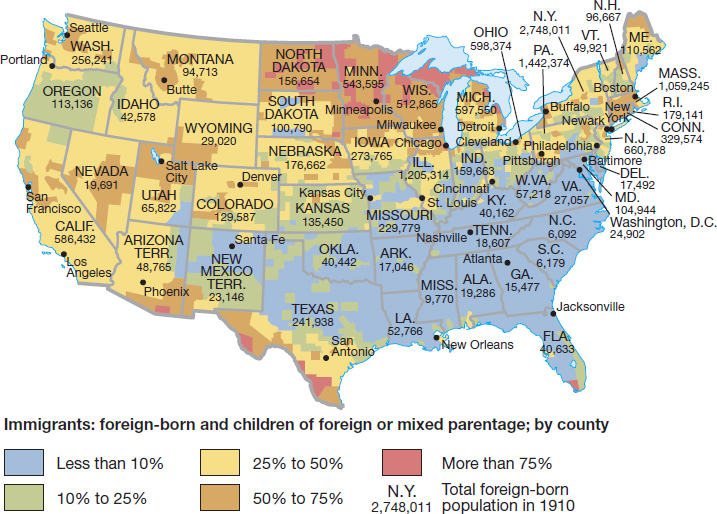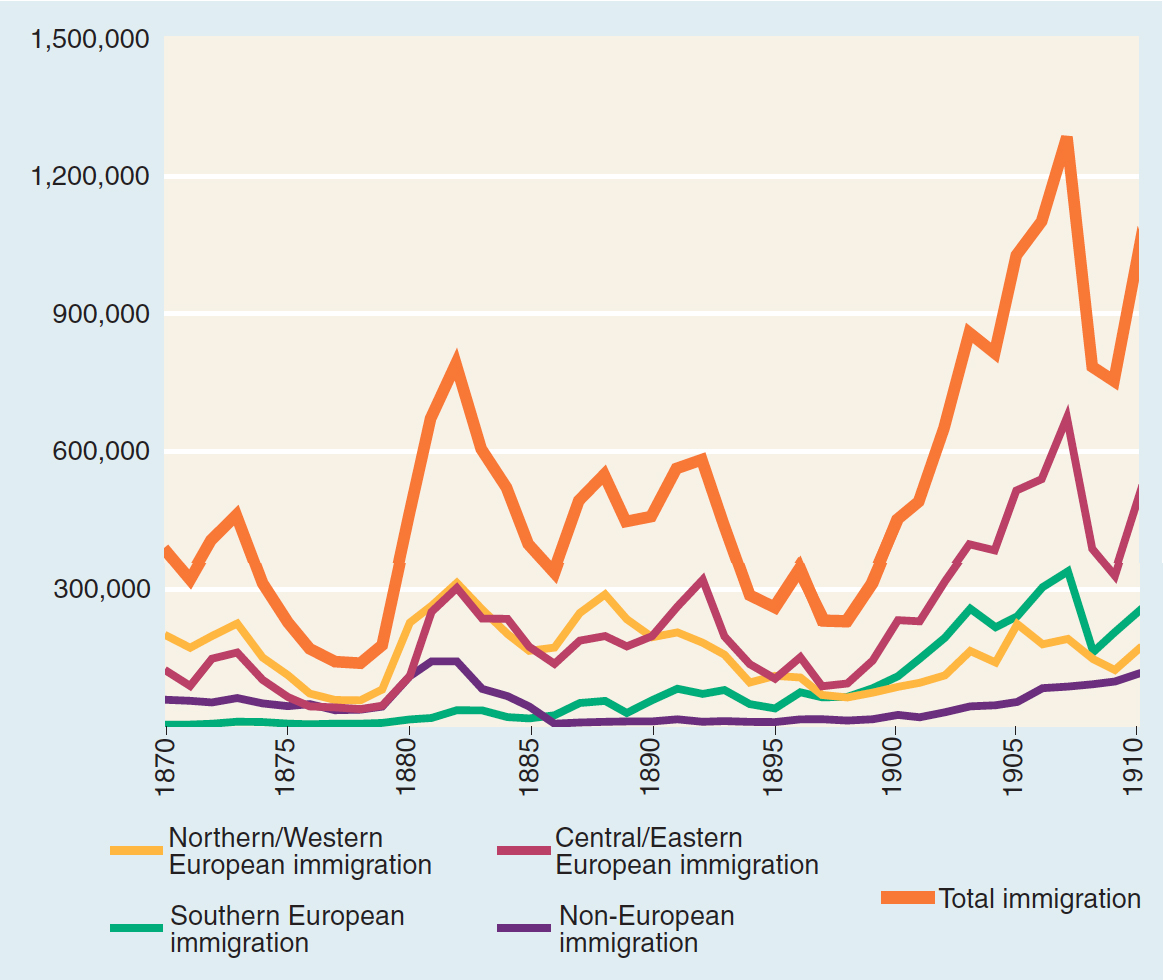The Urban Explosion: A Global Migration.
Printed Page 507 Chapter Chronology
The Urban Explosion: A Global Migration. The United States grew up in the country and moved to the city, or so it seemed by the end of the nineteenth century. Between 1870 and 1900, eleven million people moved into cities. Burgeoning industrial centers such as Pittsburgh, Chicago, New York, and Cleveland acted as giant magnets, attracting workers from the countryside. But rural Americans were by no means the only ones migrating to cities. Worldwide in scope, the movement from rural areas to urban industrial centers attracted millions of immigrants to American shores.
Map Activity 1 for Chapter 19

By the 1870s, the world could be conceptualized as three interconnected geographic regions (Map 19.1). At the center stood an industrial core that encompassed the eastern United States and western Europe. Surrounding this industrial core lay a vast agricultural domain from the Canadian wheat fields to the hinterlands of northern China. Capitalist development in the late nineteenth century shattered traditional patterns of economic activity in this rural periphery. As old patterns broke down, these rural areas exported, along with other raw materials, new recruits for the industrial labor force.
Beyond this second circle lay an even larger third world. Colonial ties between this part of the world and the industrial core strengthened in the late nineteenth century, but most of the people living there stayed put. They worked on plantations and railroads, and in mines and ports, as part of a huge export network managed by foreign powers that staked out spheres of influence and colonies in this vast region.
In the 1870s, railroad expansion and low steamship fares gave the world's peoples a newfound mobility, enabling industrialists to draw on a global population for cheap labor. When Andrew Carnegie opened his first steel mill in 1872, his superintendent hired workers he called "buckwheats" — young American boys just off the farm. By the 1890s, however, Carnegie's workforce was liberally sprinkled with other rural boys, Hungarians and Slavs who had migrated to the United States, willing to work for low wages.
Altogether, more than 25 million immigrants came to the United States between 1850 and 1920. They came from all directions: east from Asia, south from Canada, north from Latin America, and west from Europe (Map 19.2). Part of a worldwide migration, immigrants traveled to South America and Australia as well as to the United States. Yet more than 70 percent of all European immigrants chose North America as their destination.
Map Activity 2 for Chapter 19


The largest number of immigrants to the United States came from the British Isles and from German-speaking lands (Figure 19.1). The vast majority of immigrants were white; Asians accounted for fewer than one million immigrants, and other people of color numbered even fewer. Yet ingrained racial prejudices increasingly influenced the country's perception of immigration patterns. One of the classic formulations of the history of European immigration divided immigrants into two distinct waves that have been called the "old" and the "new" immigration. According to this theory, before 1880 the majority of immigrants came from northern and western Europe, with Germans, Irish, English, and Scandinavians making up approximately 85 percent of the newcomers. After 1880, the pattern shifted, with more and more ships carrying passengers from southern and eastern Europe. Italians, Hungarians, eastern European Jews, Turks, Armenians, Poles, Russians, and other Slavic peoples accounted for more than 80 percent of all immigrants by 1896. Implicit in the distinction was an invidious comparison between "old" pioneer settlers and "new" unskilled laborers. Yet this sweeping generalization spoke more to perception than to reality. In fact, many of the earlier immigrants from Ireland, Germany, and Scandinavia came not as settlers or farmers, but as wageworkers, and they were met with much the same disdain as the Italians and Slavs who followed them.
Steamship companies courted immigrants — a highly profitable, self-loading cargo. By the 1880s, the price of a ticket from Liverpool had dropped to less than $25. Would-be immigrants eager for information about the United States relied on letters from friends and relatives, advertisements, and word of mouth — sources that were not always dependable or truthful. Even photographs proved deceptive: Workers dressed in their Sunday best looked more prosperous than they actually were to relatives in the old country, where only the very wealthy wore white collars or silk dresses. No wonder people left for the United States believing, as one Italian immigrant observed, "that if they were ever fortunate enough to reach America, they would fall into a pile of manure and get up brushing the diamonds out of their hair."
Most of the newcomers stayed in the nation's cities. By 1900, almost two-thirds of the country's immigrant population resided in cities. Many of the immigrants were too poor to move on. (The average laborer immigrating to the United States carried only about $21.50.) Although the foreign-born rarely outnumbered the native-born population, taken together immigrants and their American-born children did constitute a majority in some areas, particularly in the nation's largest cities: Philadelphia, 55 percent; Boston, 66 percent; Chicago, 75 percent; and New York City, an amazing 80 percent in 1900.
Not all the newcomers came to stay. Perhaps eight million European immigrants — most of them young men — worked for a year or a season and then returned to their homelands. Immigration officers called these immigrants, many of them Italians, "birds of passage" because they followed a regular pattern of migration to and from the United States. By 1900, almost 75 percent of the new immigrants were young, single men.
Women generally had less access to funds for travel and faced tighter family control. Because the traditional sexual division of labor relied on women's unpaid domestic labor and care of the very young and the very old, women most often came to the United States as wives, mothers, or daughters, not as single wage laborers. Only among the Irish did women immigrants outnumber men by a small margin from 1871 to 1891.
Jews from eastern Europe most often came with their families and came to stay. Beginning in the 1880s, a wave of violent pogroms, or persecutions, in Russia and Poland prompted the departure of more than a million Jews in the next two decades. Most of the Jewish immigrants settled in the port cities of the East, creating distinct ethnic enclaves, like Hester Street in the heart of New York City's Lower East Side, which rang with the calls of pushcart peddlers and vendors hawking their wares, from pickles to feather beds.